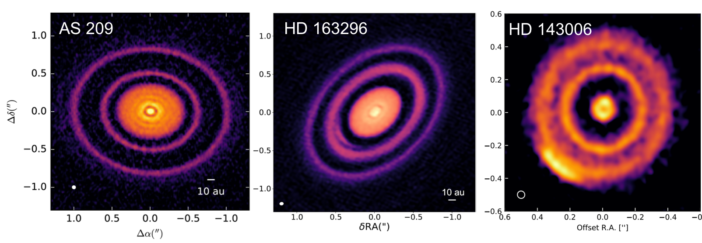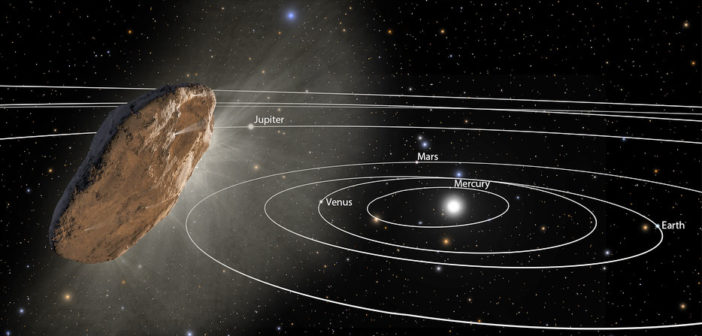Editor’s note: Astrobites is a graduate-student-run organization that digests astrophysical literature for undergraduate students. As part of the partnership between the AAS and astrobites, we occasionally repost astrobites content here at AAS Nova. We hope you enjoy this post from astrobites; the original can be viewed at astrobites.org.
*just to be clear, the aliens I am talking about are rocks and not alive nor intelligent. Sorry 🙁
Title: Hidden Planets: Implications from ‘Oumuamua and DSHARP
Authors: Malena Rice, Gregory Laughlin
First Author’s Institution: Yale University
Status: Accepted to ApJL
What if I told you that we have the opportunity to directly study other solar systems? You’d be like, “guuurrrlll, say whaaaat??” And then I’d say:
Similarly to how we can find chunks of Mars or pieces of the astroid belt on Earth, we have rocks from other solar systems flying around interstellar space — and a few just so happen to enter our solar system. This was only recently proven with the discovery of Interstellar Object (ISO) ‘Oumuamua: ‘Oumuamua was ejected from a different solar system and zoomed right into ours. Slipping between the Sun and Earth, it was detected as it started its journey back outside the solar system. ‘Oumuamua was the first object of its kind to be discovered, and it brings up the question, how many bits of other solar systems may be floating around and near us? The answer to that question can have wide implications in our understanding of solar-system formation, planet formation, and even compositions of other solar systems.
Today’s paper utilizes the ‘Oumuamua detection in addition to a recent high-resolution protoplanetary disk survey, DSHARP, to predict the number of future ISO detections. To put that number into context, the authors predict how many ISOs the new LSST survey might be able to see. To predict the average number density of ISOs (# of ISOs/volume of space) in our galaxy, astronomers have to come up with different possible methods of mass ejection from extrasolar systems. A prime opportunity to dislodge objects from a solar system takes place while the system is forming — and these dislodged objects can become ISOs. A newly forming solar system takes the form of a protoplanetary disk (see the figure below). The images below are individual protoplanetary disks shining in ~millimeter wavelengths. At these wavelengths we are most sensitive to dust of a similar size, so millimeter-sized dust grains. Each millimeter-sized dust grain is a candidate ISO; they can be flung out of their system by a newly forming massive planetesimal. These millimeter sized grains are much smaller than ‘Oumuamua, but still a good place to start in predicting how many ISOs are out there.

Three protoplanetary disks from the DSHARP survey. These images are sensitive to millimeter-sized dust grains, which show some real neat substructure like gaps (dark regions between bright regions) and rings (super bright regions, usually located next to a gap). [DSHARP collaboration]
In order to come up with a mass ejection rate (the rate at which mass is lost from the system), the authors set up simulations that had the same initial conditions as the three disk systems pictured above, and for each system they created 3 random populations of dust — the locations and sizes of dust particles were randomly distributed throughout the disk. They then let these 9 total simulations run for a week on a super computer, simulating about 20 million years of the protoplanetary disks’ lives. They then determined how much mass had left the system after that time.
The authors came up with a function of mass ejected over time for millimeter-sized grains, and from that, one can calculate an average number density of these particles in and around our galaxy (you also then need to assume a certain density of stars). The authors found that, on average, for every star there is about 0.09 Earth masses worth of millimeter-sized dust. They used their data from these simulations to extrapolate up to a broader range of ISO sizes. After all, ‘Oumuamua and any interstellar interloper that we can hope to find in our solar system is going to be significantly larger than a few millimeters. If you assume some sort of power-law distribution (put very simply, the larger the ISO is the less there is of it) you can then estimate the total mass ejected from systems similar to the three protoplanetary disks for any ISO size. In this paper, the authors found that over the disks’ lifetimes, about 24 Earth masses worth of material would be ejected from these systems as ISOs with sizes ranging from a few millimeters to a few kilometers.

Photo of the LSST site taken in May 2019. Full science operations are expected to begin in 2023. [LSST Project/NSF/AURA]
LSST’s main goals are to search for dark matter and answer questions about the formation and composition of our universe. But in this process, it will also be able to answer questions related to more Earthly subjects — not just answering questions like “How did the universe form?”, but also questions like “Is our solar system unique?”.
About the author, Jenny Calahan:
Hi! I am a second year graduate student at the University of Michigan. I study protoplanetary disk environments and astrochemistry, which set the stage for planet formation. Outside of astronomy, I love to sing (I’m a soprano I), I enjoy crafting, and I love to travel and explore new places. Check out my website: https://sites.google.com/umich.edu/jcalahan

2 Comments
Pingback: Daily Log (2019-10-02) - Study Astrophysics
Pingback: Allgemeines Live-Blog ab dem 18. Oktober 2019 | Skyweek Zwei Punkt Null